You don’t have to be an arachnophobe to be nervous around spiders. But the reality is that spiders are generally beneficial, as they help keep insect pests at bay. However, although most spiders generally run away when disturbed, a few can get aggressive and some can deliver a painful and potentially life-threatening bite. So, which are the spiders around Newcastle and the Hunter Valley that you should be most concerned about?
Sydney funnel-web
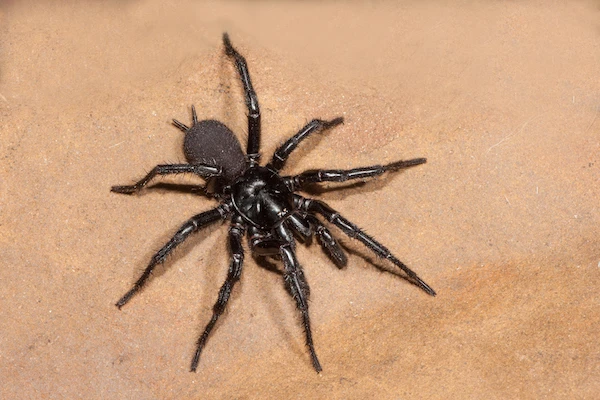
Funnel-web identification:
There are actually a few species of funnel-web spider but the most common around the Hunter Valley is the Sydney funnel-web. It’s a large black, ground dwelling spider with a body length up to 35 mm and a leg span of around 70 mm. They have a shiny carapace (back) and 4 obvious spinnerets at the end of the abdomen. However, for the non-experts it can be easy to confuse the funnel-web with other large, black spiders such as the mouse spider, the wishbone spider, certain spiders of trapdoor spider and even the black house spider. As such if you get bitten by a black spider and you cannot identify it, you should treat it as a funnel-web bite and call for medical assistance immediately.
Funnel-web interesting facts:
The female funnel-web is rarely encountered, generally remaining in her burrow or under logs. She lines her burrow with silk with a network of trip lines, creative a funnel like web, which is how they get their name. However, the male spider is often found on the move during the warmer months, when looking for a mate. It’s the male that can be found moving into houses, hiding in shoes kept outside or falling into swimming pools. Word of warning: funnel-webs can stay alive for several hours submerged under water, breathing air trapped in bubbles on its hairs, so don’t use your hand to pick up any spiders you find in the pool (even if they look dead!).
Funnel-web bite information:
Although the male spider is smaller than the female, it’s bite is more deadly. And as it’s the one that wanders around it is more likely to come into human contact. When threatened the funnel-web raises up, ready to strike. If it does bite it comes down with some force and is strong enough to bite through shoes and toenails. The bite is immediately painful and the victim will start to have tingling around the lips and salivating, before sweating, nausea and shortness of breath follows. Headaches, high blood pressure, confusion and agitation follows before passing out.
If bitten by a funnel-web, it is treated differently to other spider bites and in fact is treated more like a snake bite. The patient should be kept still and calm, with a pressure bandage applied to the effected limb. Call for medical assistance immediately and if possible, get a photograph of the spider. The good news is, that since anti-venom was invented back in the 1980s, there have been no fatalities from funnel web bites.
Redback Spider
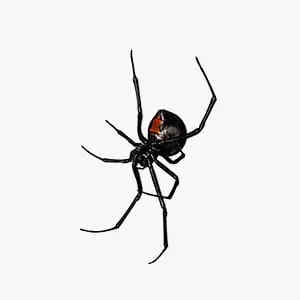
Redback spider identification:
I think everyone knows what a redback looks like, but the black spider with red hourglass mark is only the adult female. Younger females have less distinct markings, often including white, and males are a lot smaller. Their webs are very messy, like a badly constructing fishing net, often containing debris like dead leaves. They tend to build their webs in dry areas – under furniture, rocks and logs, but also in roof voids around downlights.
Redback interesting facts:
Redback males go through a mating ritual to try and get close enough to mate without being eaten. When the do get close enough to mate they do a headstand and offer his abdomen to the female as a romantic snack!
Redback spider bite information:
Officially there are around 2,000 reported redback bites each year, but the number of actual bites is probably a lot higher. This is because is it a very common spider and often hides in cracks and crevices around the house and yard – places where it comes into regular contact with humans. The pain of the bite increases over time, with the victim starting to sweat, included at the bite site. Weakness, nausea and vomiting follows. With a redback bite you should still seek medical attention, particularly for young children. Do not apply a pressure bandage, just apply an ice pack to the bite site.
White-tailed spider
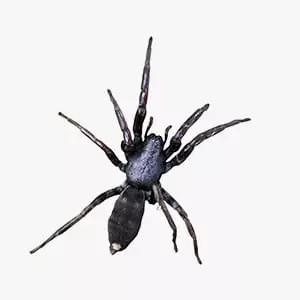
White tail spider identification:
White-tailed spiders are quite easy to identify as they are a slim, elongated spider. They have a grey / black body with 4 pale spots and a fifth white spot at the end of the abdomen – the “white tail”. The legs are brown / orange with dark bands. White-tailed spiders are a hunting spider and don’t build web
White-tailed spider interesting facts:
The favourite food of white-tailed spiders are other spiders, including black-house spiders. So, a general pest spray or spider treatment which takes care of the web-building spiders will make your home less attractive to white-tail spiders, as there will be no food for them!
White-tailed spider bite information:
The white-tail spider bite is very painful, with an initial burning sensation, followed by swelling and itching, but there is no need for any special medical treatment. Clean the bite site with disinfectant and apply an ice pack. The idea that white-tail spider bites cause flesh to decay is a bit of an urban myth, a scientific study on white-tail spider bites, demonstrated there was no evidence to support this concept. However, it is true that any spider bite can develop into an ulcer, if bacteria from the spiders’ jaw or from scratching the bite get into the skin.
Black house spider
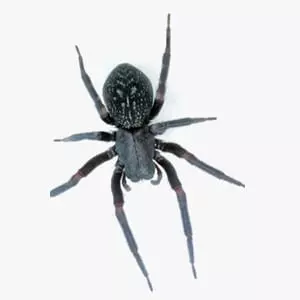
Black house spider identification:
The black house spider has a grey / black carapace (back) with a brown and white mottled abdomen. The legs are dark with lighter stripes. Their body can be up to 18mm long and their legs span up to 30 mm. They are readily identified by their webs which are dense and funnel-like, often located around windows, door frames, eaves and vents.
Black house interesting facts:
There is also a very similar looking related species, the grey house spider. Black house spiders are the favourite prey of white-tailed spiders.
Black house spider bite information:
Although the bite can be quite painful and may results in swelling and occasionally nausea and sweating there is not normally any reason to call for medical attention. Apply an icepack to the area and seek medical attention if symptoms persist. However, normally the spider is quite shy and disappears into its web when disturbed.
Mouse spider
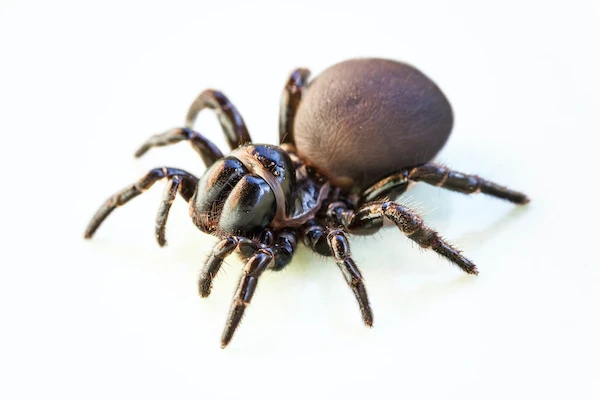
Mouse spider identification:
There are several species of mouse spider and they are the spider most likely to be confused with the funnel web spiders. However, they are more of a stout spider than the funnel-web and have bulbous head with over-sized jaws. The males are smaller and more elongate than the females. They also have short spinnerets. They more commonly found in the country areas as they live in open forest and shrubland. The most common mouse spider is the red-headed mouse spider, which gets its name from the bright red head of the male spider.
Mouse spider interesting facts:
The red-headed mouse spider is unusual for this group of spiders in that the young spiders (spiderlings) disperse by ballooning (letting out a silk rope and using the wind to carry it away). They can travel for several kilometres by ballooning.
Mouse spider bite information:
Mouse spider bites are rare but have been known, with the symptoms similar to funnel-web spiders and victims are generally given the funnel-web anti-venom when bites occur. As such, apply the pressure bandage first aid in case of a suspected bite.
Not on this list are the range of huntsman spiders. Large and scary as they may be, they are generally very timid, unless it’s a female guarding their egg sac, and will generally try and escape rather than bite. In cases where they do bite, their bite is quite mild and you should follow the standard spider bite first aid.
The generally recognised first aid treatment for spider bites is to sit the victim down, clean the bite site and apply an ice pack. In case of worsening symptoms or allergic reaction, call for medical help. The exception to the rule is a suspected funnel-web or mouse spider bite, when a pressure bandage needs to be applied to the limb with the bite and medical help must be called immediately.
If you have any concerns about spiders at your property, Rebel Pest Professionals can provide specialist spider treatments to keep your family and pets safe.
